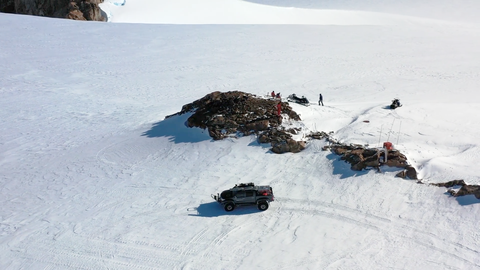Feb 20, 2024
Ice, Ice, Baby! TUD researchers measure how much ice the Antarctic is losing
The effects of global climate change can also be seen in the changes to the ice mass in the Antarctic. TU Dresden researchers are using geodetic methods to measure how much and where these changes are occurring. To do so, they are using both on-site GPS measurements in the Antarctic and satellite data.
"If we want to deduce the loss of ice mass in Antarctica, we also need to understand how the solid ground reacts to changes in ice mass," Maria Kappelsberger explains. The geodesist from TU Dresden already traveled to the Antarctic herself on the Alfred Wegener Institute's polar research ship “Polarstern" to take measurements on site. The data collected there is of great relevance for calculating how much ice the Antarctic is losing and in which regions the decline is most pronounced.
"Not all ice is the same," explains Dr. Matthias Willen, who also works at the Chair of Geodetic Earth System Research. There is a distinction between sea ice, frozen seawater floating on the ocean, and glacial ice on land. At the South Pole, glacial ice covers an entire continent: Antarctica. This ice sheet is several kilometers thick and comprises almost 70 percent of the Earth's entire fresh water. "If more glacial ice slides into the ocean than is replaced by snow, then the mass of this Antarctic ice sheet changes."
Since 2002, such changes have been measured by the GRACE satellite mission and its successor mission GRACE Follow-On. The principle behind it: Two structurally identical satellites that constantly follow each other on the same orbit measure the Earth's gravitational field. If one of the satellites is attracted by a large mass of ice and approaches it, the other follows behind. The changes in the orbit and in the distance between the satellites allow the researchers to calculate how the mass of ice on Earth changes. The data points result in a time series that visualizes the monthly changes. The data also shows where the changes are most pronounced.
Moreover, Maria Kappelsberger's research shows that the changes in ice mass also have a direct effect on the underlying continent. The weight of the ice deforms the rock beneath the glacier and causes it to sink. As the ice mass decreases, this in turn causes the solid earth to rise. "We can measure these deformations using GPS and other satellite navigation systems directly on-site in Antarctica," the researcher explains. In West Antarctica, where the greatest losses of ice mass can be observed, we also see the greatest deformations. "We observe uplifts of several centimeters per year there." The changes in the ice mass also lead to movements in the Earth's viscous mantle material. The orbits of the GRACE and GRACE Follow-On mission satellites are influenced not only by changes in the ice, but also by mass redistributions in the Earth's interior.
"The mass changes in the Antarctic are only part of the effects of global climate change," Matthias Willen emphasizes. "However, measuring the loss of ice mass clearly shows us that the Antarctic will significantly contribute to the global sea level rise in the future and thus to changes in the Earth's climate system." At present, researchers from TU Dresden are again on an expedition with the "Polarstern" in the Antarctic to find out more about the effects of climate change at the South Pole.
Maria Kappelsberger and Matthias Willen speak about their research in our "Short question" video series. Video: https://youtu.be/X7Vus2HU4S8

